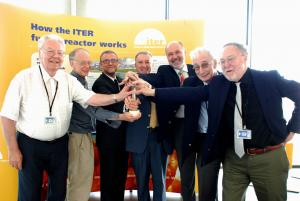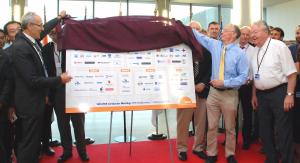One last time the band got together again. Like old friends they didn't need words to salute each other—a slap on the shoulder at the coffee table, a respectful nod when entering the door was sufficient. They had come a long way but the job is nearly done and it was time to say goodbye.
Last week, from 15 to 17 September, representatives from the applied superconductivity community, members of the ITER Organization and Domestic Agency magnet teams, and suppliers—the "band" as Superconductor Section Leader Arnaud Devred calls them—convened for one last time to celebrate the wind-down phase of an eight-year campaign to procure ITER's superconductors.
Since 2008 the group has met twice yearly to facilitate the exchange of information, share experience, and identify synergies; now, with the manufacturing of the ITER superconductors drawing to a close, it was time to look back and celebrate.
For a special event held on the second day of the meeting, some of the grands seigneurs of the superconducting world were present in the amphitheatre of ITER Headquarters. One of them was Bruce Strauss, program manager at the Office of High Energy Physics (US Department of Energy) and an eye-witness to the fast development of superconductors and their applications over the last decades.
Applauding the ITER Organization for its conductor procurement strategy, which has been instrumental in establishing processes and systems to standardize conductor production and testing around the world, Strauss said: "You have set the bar for managing a multi-vendor, in-kind acquisition strategy. My warm congratulations on the demonstrated success of this venture."
Valued at more than EUR 600 million, the 11 conductor Procurement Arrangements signed by the ITER Organization between 2007 and 2010—covering the procurement of conductors for the large toroidal field, poloidal field and central solenoid magnets as well as correction coils and feeders—represent one of the project's largest in-kind procurement packages. Six out of the seven ITER Members (China, Europe, Japan, Korea, Russia and the United States) have taken part.
The ITER Organization, in close collaboration with CERN, pioneered reporting, document handling and quality assurance procedures to ensure that strands produced by suppliers all over the world achieved the same required performances. More than 12,000 control points, relying on over 30,000 strand critical measurements, have been cleared in a timely fashion through a web-based database developed by the ITER Central Team, enabling production to run smoothly at approximately 20 suppliers around the world. Today, 70 percent of the manufactured conductor unit lengths have been accepted by the ITER Organization.



